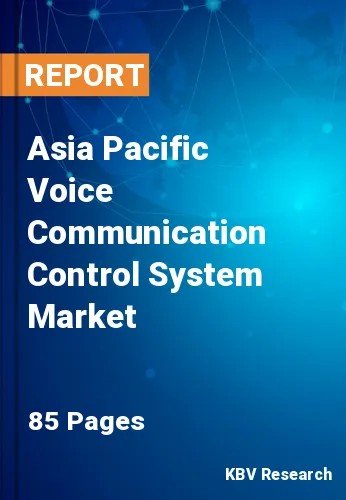The Asia Pacific Voice Communication Control System Market would witness market growth of 7.1% CAGR during the forecast period (2022-2028).
Most VCSs can connect several devices and are developed with controller education in mind. As a result, a trainer for on-the-job training can access the VCS through their tools and act promptly as needed. Additionally, monitoring the trainee's phone calls with this setting is easier. Finally, most VCSs include extra details on the working positions inside the same ATS unit, such as whether they are currently on the phone or another sector is using a particular frequency.
Some significant trends also characterize the VCCS technology. Circuit-switched networks have been phased out in favor of packet-switched networks, on which VCCS previously relied. Adoption of IP-based systems like VoIP-based designs are becoming more and more common in voice communication systems. Due to this development, VCCS benefit from all IP-based networks' features, including enhanced scalability and lower costs. Additionally, VCCS are increasingly merging with data networks, enabling resource fusion and developing new services and applications.
Worldwide air traveler growth has increased demand for new airport construction and commercial aircraft deliveries. Developing nations are seeing fast growth in aviation traffic. The development of the air traffic management infrastructure is expected to grow as the number of airports increases. Consequently, air traffic control operations will be effective and seamless owing to upgraded ATM infrastructures.
Due to heavy air traffic, commercial aircraft are more in demand in China and India. As a result, commercial aircraft deliveries are increasing in high-growth regions, necessitating advanced voice communication systems to improve air traffic control operations. Additionally, to enhance aircraft safety and security, the commercial airport modernization initiative has resulted in a growing implementation of the VoIP VCCS in the air traffic control (ATC) towers.
The China market dominated the Asia Pacific Voice Communication Control System Market by Country in 2021; thereby, achieving a market value of $448.3 Million by 2028. The Japan market is registering a CAGR of 6.5% during (2022 - 2028). Additionally, The India market would showcase a CAGR of 7.7% during (2022 - 2028).
Based on Component, the market is segmented into Hardware, Software and Services. Based on End-use, the market is segmented into Commercial and Defense. Based on Application, the market is segmented into Air Traffic Control, Vessel Traffic Control, Disaster & Emergency Management and Others. Based on countries, the market is segmented into China, Japan, India, South Korea, Singapore, Malaysia, and Rest of Asia Pacific.
Free Valuable Insights: The Worldwide Voice Communication Control System Market is Projected to reach USD 5.2 Billion by 2028, at a CAGR of 6.4%
The market research report covers the analysis of key stake holders of the market. Key companies profiled in the report include Rohde & Schwarz GmbH & Co. KG, Thales Group S.A., Saab AB, L3Harris Technologies, Inc., S.I.T.T.I. S.p.A., Copperchase Limited, Indra Sistemas, S.A., Morcom International, Inc., Frequentis AG and Applied Electro Magnetics Pvt. Ltd.
By Component
By End-use
By Application
By Country
Our team of dedicated experts can provide you with attractive expansion opportunities for your business.

